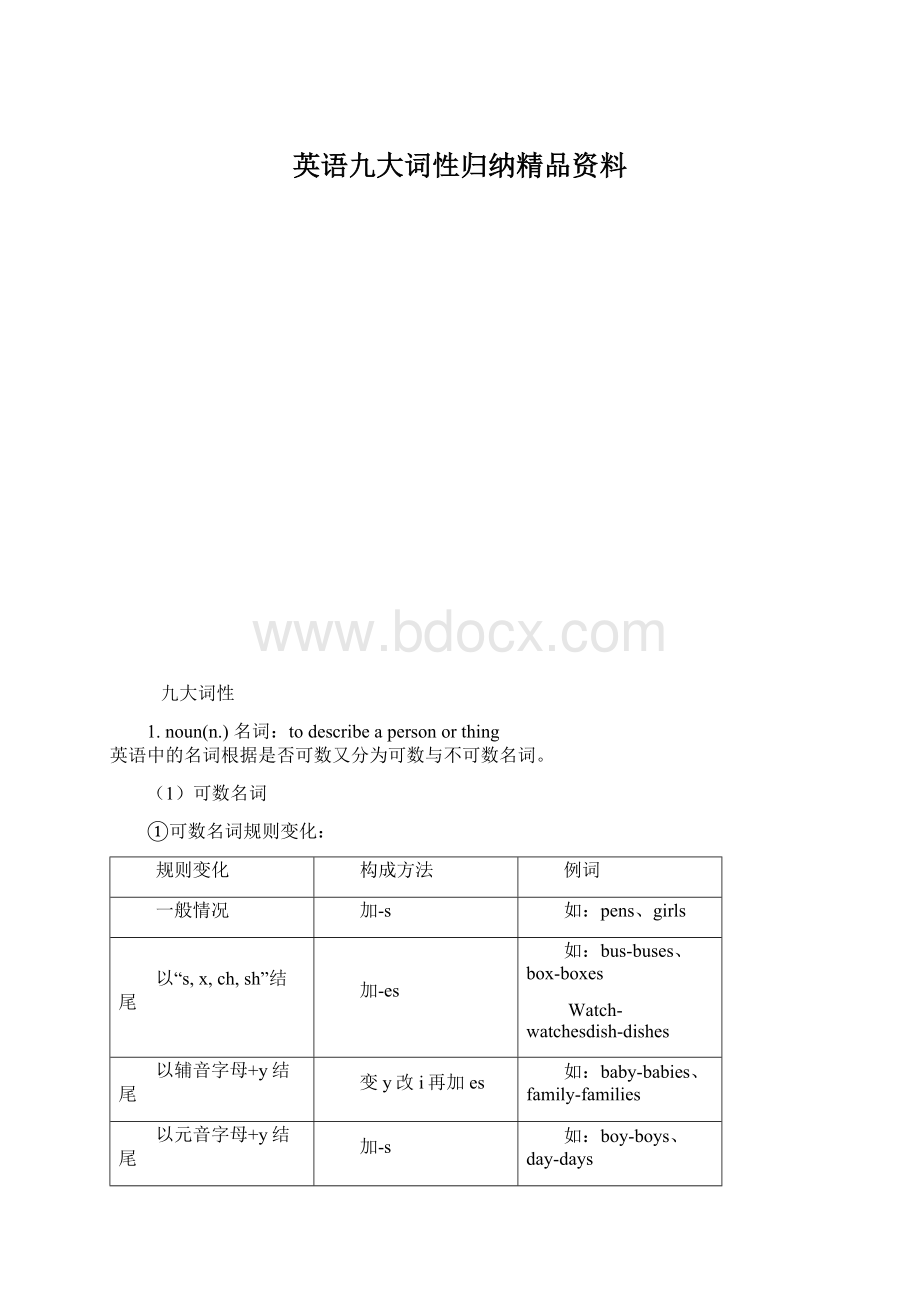英语九大词性归纳精品资料.docx
《英语九大词性归纳精品资料.docx》由会员分享,可在线阅读,更多相关《英语九大词性归纳精品资料.docx(14页珍藏版)》请在冰豆网上搜索。

英语九大词性归纳精品资料
九大词性
1.noun(n.)名词:
todescribeapersonorthing
英语中的名词根据是否可数又分为可数与不可数名词。
(1)可数名词
①可数名词规则变化:
规则变化
构成方法
例词
一般情况
加-s
如:
pens、girls
以“s,x,ch,sh”结尾
加-es
如:
bus-buses、box-boxes
Watch-watchesdish-dishes
以辅音字母+y结尾
变y改i再加es
如:
baby-babies、family-families
以元音字母+y结尾
加-s
如:
boy-boys、day-days
以辅音字母+o结尾
加-es
如:
potatoes、tomatoes
以元音字母+o结尾
加-s
如:
photos
以f或fe结尾的
变f或fe为v再加es
如:
half-halves、wife-wives
thief-thieves
②可数名词不规则变化
A、单复数同形:
deer-deerfish-fishsheep-sheep
B、词尾发生变化:
ox-oxenchild-children
C、内部单词发生变化:
foot-feettooth-teethgoose-geesewoman-womenman-menmouse-micepoliceman-policemen
D、表示某国人时,中日不变,英法变,其他国家加s:
(1)Chinese-ChineseJapanese-Japanese
(2)Frenchman-FrenchmenEnglishman-Englishmen
(3)German-GermansRussian-RussiansAmericans
③特殊情况
i.另一些名词本身即是复数形式,不可用作单数。
如:
people,police,trousers,pants,clothes,scissors
ii.有些名词以s结尾,但不是复数形式,如:
news,maths,physics,politics
iii.有些名词既是可数名词又是不可数名词,如:
room(空间)—aroom(房间)work(工作)—works(著作)
(2)不可数名词:
(前面不能用a,an等来修饰)
①到目前为止我们所学的不可数名词有:
A液体类:
water:
juice,tea,soup,milk,cola,coffee
B肉类:
meat,beef,pork,mutton
C粉末类:
bread
D抽象名词类news,information,money,advice,friendship,work,homework,
houseworkschoolwork,help,fun,health,price
E食物类:
food,broccoli, rice,porridge,junkfood,tofu
②不可数名词计量的表达:
A个数单位词:
piece(张、片、块、条),如:
apieceofnews
B容器单位词:
bottle(瓶),bag(包),box(盒、箱)如:
abottleofmilk
C类别单位词:
kind(种、类)
D度量衡单位词:
kilo(千克、公斤)
▲翻译下面的词组:
1.两杯咖啡:
2.四块面包:
3.七袋大米:
4.八只鹿:
5.一滴水:
6.三个男孩:
(3)名词所有格(翻译为:
……的):
构成方法
例句
一般在有生命名词后加’s构成
Linda’sdesk
若以s结尾复数名词,则在s后加’s,若不是以s结尾复数名词,则加’s
theboys’friends
thechildren’sday
表示几个人共同的东西,只在最后一个人后加’s
LucyandLily’smother
表示几个人都分别有的东西,则每个人都加’s
Lucy’sandLily’sbook
表示时间、距离的名词可以加’s或’构成所有格形式
Today’snewspaper
Fifteenminutes’walk
表示某人的家、店铺、诊所时,常省略所有格后面的名词
atmyuncle’s
=atmyuncle’shome
表示无生命事物的所有关系:
一般用..of..结构来表示无生命的名词所有格:
amapofChina中国地图thenameofthefilm书的封面
thecoverofthebook电影的名字
▲Ⅰ用括号中所给词的适当形式填空:
1.Thetwogirlsare(Japan)
2.The(baby)areasleep
3.Doyouknowthetwo(manteacher)?
▽当一个名词作定语说明另一个名词时,这个名词一般用单数。
eg.anappletree,fiveappletrees,agirlfriend,twogirlfriends,atwinsister
但是,当man和woman作定语修饰复数名词时,就要用其复数形式。
eg.twomenteachers,threewomendoctors
4.The(child)arewashingtheir(foot).
5.Therearetwo(people)andlotsof(sheep)inthefields.
6.September10is(teacher)Day.
7.Ithinkphysics(be)moreinterestingthanmaths
8.Don’tyouthinkthe(radio)aretoonoisy?
9.Whose(knife)arethese?
10.“Whosehouseisthis?
”“It’sthe(Smith)”.
2.verb(v.)动词
eg.do,make,go,take,bring
英语中动词根据其后是否可以加宾语又分为:
Vt.(及物动词)eg.speak,give,sing
Vi.(不及物动词)eg.run,work
英语中动词有5中形态:
原形,第三人称单数形式,过去式,过去分词(用于完成时或被动语态中),现在分词
dodoesdiddonedoing
workworksworkedworkedworking
I动词第三人称单数形式变化(三单变化)
规则变化
动词原形
三单变化
直接+s
help/make
helps/makes
以字母s/x/ch/sh为结尾+es
guess/wash/watch
guesses/washes/watches
以“辅音字母+y”为结尾,变y为i+es
study/carry/fly
studies/carries/flies
以o为结尾的部分单词+es
do/go
does/goes
特殊变化
have
has
II.动词过去式和过去分词变化
(1)规则变化
规则变化
动词原形
过去式和过去分词
直接+ed
work/call/want
worked/called/wanted
以“辅音字母+y”为结尾,变y为i+ed
study/try/carry
studied/tried/carried
重读闭音节元音+辅音结尾+ed
stop/plan
stopped/planned
以字母e为结尾+d
live/hope
lived/hoped
(2)不规则变化需要单独记忆
III动词的现在分词形式变化
规则变化
动词原形
现在分词
直接+ing
help/work
helping/working
以e为结尾,去e加ing
make/move
making/moving
重读闭音节元音+辅音结尾+ing
get/begin
getting/beginning
以ie为结尾,变ie为y+ing
lie/die/tie
lying/dying/tying
⑴时态(找时间标志词):
一般现在时:
⏹结构:
am/is/areplay/plays
⏹判断:
sometimes,often,usually,always,every,
在if/assoonas等复合句中,主将从现
1.Ifyou________hard,youwillpasstheexam.
A.studiesB.study
C.willstudyD.isstudying
现在进行时:
⏹结构:
am/is/areplaying
⏹判断:
Look,Listen,now,Where’ssb?
⏹典型例题:
1.--Where’smom?
Iwanttogoshoppingwithher.
--She______inthebedroom.
A.readsB.read
C.isreadingD.hasread
一般过去时:
⏹结构:
was/wereplayed
⏹判断:
yesterday,last…,…ago及语境.
⏹典型例题:
1.--Youlooktired.Whatdidyoudoyesterday?
--I______tillnight.
A.worksB.worked
一般将来时:
⏹结构:
willplay
⏹判断:
tomorrow,next…及语境,
在if/assoonas等主从复合句中,主将从现.
⏹典型例题:
1.She________meassoonasshegetsthere.
A.callsB.callC.calledD.willcall
过去进行时:
⏹结构:
was/wereplaying
⏹判断:
atthattime,atthistime,yesterday,by+过去时间,
bytheendof+过去时间常用于带有when/while的主从复合句中.
⏹典型例题:
1.Mom______inthekitchenwhenIgothome.
A.cooksB.cook
C.wascookingD.cooked
2.I________myhomeworkatthistimeyesterday.
A.didB.doC.willdoD.wasdoing
现在完成时(动作从过去持续到现在):
⏹结构:
has/haveplayed
⏹判断:
just,already,yet,ever,never,sofar(到目前为止)
次数(once,twice)
since+时间点,for+时间段,how